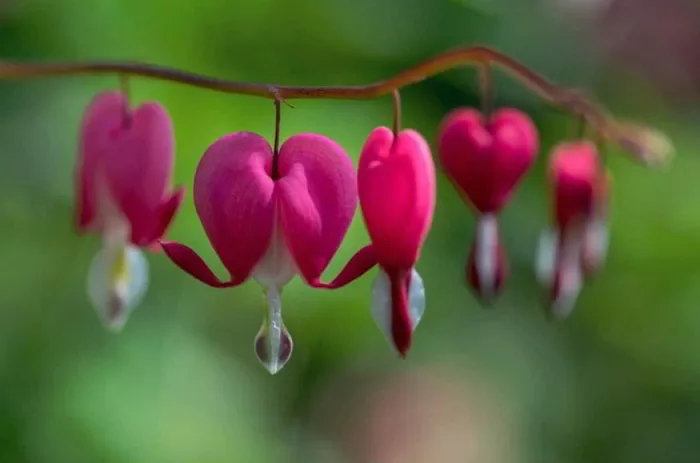In the serene tapestry of nature, flowers have long been regarded as silent poets, conveying emotions and messages through their delicate forms. Among these floral messengers, the bleeding heart flower holds a special place. With its heart-shaped blooms and drooping petals, it whispers tales of love, vulnerability, and hope. This article delves into the rich symbolism of bleeding heart flowers, exploring their cultural significance, historical associations, and the emotions they evoke.
A Heartfelt Introduction
Bleeding heart flowers, scientifically known as Dicentra spectabilis, are renowned for their distinctive heart-shaped blooms with a single drop-like petal hanging below. These flowers, often found in woodland gardens and shaded areas, have a timeless charm that has captivated gardeners and poets alike. Their unique appearance makes them more than just a pretty plant; they are symbols of deep emotions and meaningful messages.
The Origins of Bleeding Heart Symbolism
To understand the symbolism of bleeding heart flowers, we must journey back to their origins. Native to Asia, these flowers were introduced to the Western world in the 19th century. Their heart-shaped flowers immediately caught the imagination of Victorian gardeners, who were fond of assigning meanings to flowers. In the Victorian language of flowers, known as floriography, bleeding hearts came to symbolize romantic love and deep affection. The drooping heart shape was seen as a representation of a heart broken by love, adding a layer of emotional depth to its symbolism.
Love and Longing
One of the most prominent symbols associated with bleeding heart flowers is love. The heart-shaped blooms are a universal symbol of love, and the bleeding heart takes this symbolism further. The drooping heart with a tear-like petal suggests a heart broken by love, making it a poignant symbol of unrequited love or lost love. In many cultures, these flowers are given as gifts to express deep, unspoken feelings. They can convey the pain of separation or the hope of rekindling a lost romance.
Hope and Resilience
Despite their delicate appearance, bleeding heart flowers are surprisingly resilient. They thrive in shaded areas and can survive in challenging conditions. This resilience has led to another layer of symbolism: hope and perseverance. The bleeding heart flower reminds us that even in times of heartbreak or adversity, there is always hope for healing and renewal. Its ability to bloom year after year symbolizes the enduring nature of love and the human spirit.
Cultural Significance
Bleeding heart flowers have a rich cultural history that extends beyond their botanical significance. In Japanese culture, these flowers are often associated with the story of a young girl who was heartbroken after her lover was killed in battle. Her tears turned into the beautiful bleeding heart flowers, symbolizing her undying love and sorrow. In Chinese culture, the bleeding heart flower is seen as a symbol of pure love and loyalty, often depicted in traditional art and literature.
Gardening Tips for Bleeding Hearts
For those who wish to grow bleeding heart flowers in their gardens, understanding their care requirements is essential. Bleeding hearts thrive in well-drained soil and partial to full shade. They prefer cool, moist conditions and can be sensitive to heat and drought. Planting them in a shaded area with rich, organic soil will ensure they flourish. Regular watering and mulching can help maintain the soil moisture they need. These flowers are not only beautiful but also relatively low-maintenance, making them a perfect addition to any garden.
Companion Plants for Bleeding Hearts
When designing a garden with bleeding heart flowers, it’s important to consider companion plants that can enhance their beauty and create a harmonious environment. Ferns, hostas, and other shade-loving plants make excellent companions for bleeding hearts. Their lush foliage can provide a beautiful backdrop for the delicate blooms, while also sharing similar growing conditions. By carefully selecting companion plants, you can create a woodland garden that feels like a peaceful retreat.
The Language of Flowers in Modern Times
In today’s world, the language of flowers may seem like an old-fashioned concept, but it still holds relevance. Bleeding heart flowers continue to be a popular choice for weddings, anniversaries, and other romantic occasions. They can be used in floral arrangements to convey deep emotions and create a sentimental atmosphere. Whether given as a gift or displayed in a garden, bleeding hearts speak a language that transcends words.
Conclusion
Bleeding heart flowers are more than just a beautiful addition to any garden; they are symbols of love, hope, and resilience. Their unique heart-shaped blooms and drooping petals convey deep emotions, making them a meaningful choice for those who wish to express their feelings. From their origins in Asia to their popularity in Western gardens, bleeding hearts have left an indelible mark on the world of floriculture. Whether you grow them in your garden or receive them as a gift, these flowers remind us of the enduring power of love and the beauty of nature.


